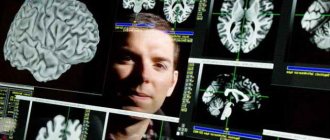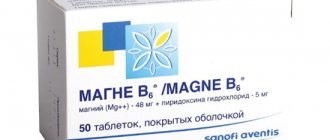Learn more about diseases starting with the letter “L”: Lacunar cerebral infarction, Mild cognitive impairment, Leukodystrophy, Schilder’s leukoencephalitis, Drug-induced parkinsonism, Lethargic encephalitis, Frontal syndrome, Lumbago, Lumboischialgia.
What is mild cognitive impairment
If the patient has a slight deterioration in cognitive functions compared to the state preceding the onset of the pathology, then we are talking about a cognitive disorder. The symptomatic picture of this disorder is poorly expressed. Typically, patients complain of difficulty concentrating, forgetfulness, and fatigue during mental effort. Diagnostics includes a neuropsychological or pathopsychological study of the cognitive sphere, consultation with a neurologist and psychiatrist. MCI requires an integrated approach to therapy, accompanied by the use of medications, correction of diet and daily routine, and psychocorrective exercises.
Pathogenesis
The pathogenetic mechanisms of MCI are varied and depend on the leading etiological factor. In old age, processes associated with aging influence: weakening of attention, focus, memory. Clinical and experimental psychological studies confirm that age-related deterioration of cognitive functions develops independently, without concomitant psychoneurological diseases against the background of natural processes of aging of the central nervous system (age-related loss of neurons, changes in nerve fibers of the white matter and synaptic apparatus).
In 68% of cases, MCI occurs on the basis of cerebrovascular disorders, in which a decrease in the cognitive sphere is caused by pathological changes in cerebral vessels and cerebral circulatory insufficiency. In second place in terms of prevalence is degenerative damage to brain tissue (atrophy).
General information about the disease
Translated from Latin, “cognitive” means “familiarization, cognitive.” Consequently, mild cognitive disorder (MCI) is a slight deterioration of a whole complex of intellectual abilities: concentration, memory, reproduction and processing of information, the ability to abstract and solve logical problems. However, such a disorder does not reach the level of dementia, mental retardation or amnestic syndrome. Its development is provoked by an organic or infectious disease, and MCI can occur before, during or after the underlying disease. It most often occurs in people with a low level of education. Among the patients, about 10% are elderly people over 65 years of age; it is worth noting that the majority begin to develop a symptomatic picture characteristic of Alzheimer’s within a year.
Characteristics of the pathology
Not every person knows what cognitive functions are. There are quite a lot of them, and they represent abilities that allow a person to rationally perceive the world, assess the environment, remember and analyze information, and also perform other natural tasks.
If problems arise in the brain, then mild cognitive impairment will begin to develop. They significantly affect the quality of life, for this reason every person should promptly consult a doctor and begin treatment.
Disorders often affect the following brain functions:
- Memory. It becomes much more difficult for a person to remember information, and moments that have already happened in the past can fly out of their heads. Recent events are erased first, and then other memories are affected.
- Intellectual abilities. When they are disordered, it becomes much more difficult for a person to think logically, analyze the information received, and draw conclusions. He loses the ability to cope even with ordinary tasks.
- Attention. The patient has problems concentrating. He cannot highlight important information and turn his attention to the desired subject. Increased absent-mindedness can interfere with your life, so you shouldn’t wait until your health gets worse.
- Speech. Often a person cannot express himself fully, choose the right words, or speak in general. In such a situation, the patient may not even understand what other people are saying to him.
- Orientation in space. A person can easily get lost in an unfamiliar place. At the same time, he may not find his way even in a familiar environment. In such a situation, the patient cannot be allowed out of the house, as he can easily get lost.
These are just some of the cognitive functions that can be impaired when the disease appears. A person often begins to need outside help because he cannot take care of himself on his own. Working capacity is often lost due to deterioration of health and immediate intellectual abilities. In any case, you will need to see a doctor if a person wants to achieve positive results in therapy.
Mild cognitive impairment may present differently in each person. It will definitely be difficult to say what manifestations will be in a particular situation. Much depends on how severely the person is ill, as well as what brain structures are affected. For this reason, each case is considered individual, but it is possible to address common symptoms that occur in many people. Signs:
- Rave. The person begins to express illogical thoughts that are false and irrational. At the same time, the person is not going to give them up.
- Problems with the thought process. It becomes much more difficult to cope with familiar tasks that previously did not seem difficult.
- Memory impairment. At first, a person does not remember what happened quite recently. Even memories from the distant past may gradually be lost.
- Hallucinations. They can be both visual and auditory. Such signs should definitely alert people, because they are not considered normal.
- Motor activity of an obsessive nature. Moreover, all movements do not have a specific goal.
- Problems with concentration. The person becomes extremely inattentive, and over time the situation only gets worse.
- Drowsiness. A citizen constantly wants to sleep during the day, while at night he, on the contrary, is active.
- Apathy. It can be noticed that the patient experiences indifference to current events and people. In addition, increased irritability and aggressiveness may occur.
Patients with mild cognitive impairment may not even realize that something is wrong with them. They lose the ability to critically evaluate their behavior and lose tact. If loved ones notice the symptoms described above, then you should definitely contact a medical specialist. Only in this case will you be able to improve your health.
Causes
>This pathology is not a separate disease, but an intermediate state between normal and dementia. MCI is provoked by pathological processes in the central nervous system:
- Vascular diseases: multi-infarction conditions, cerebral infarctions, combined vascular and hemorrhagic brain damage, chronic cerebral ischemia. Cognitive impairment can be observed during the course of the underlying disease and as consequences;
- Neurodegenerative diseases, which include: Huntington's chorea, Parkinson's disease, senile dementia of the Alzheimer's type, progressive supranuclear palsy and dementia with Lewy bodies. Cognitive disorders precede the development of the main symptoms;
- In demyelinating pathologies, MCI manifests itself in the early stages of multiple sclerosis, progressive paralysis, and progressive multifocal leukoencephalopathy. Cognitive impairment increases as the underlying disease progresses;
- Traumatic brain injuries can cause permanent or transient cognitive impairment during the post-traumatic injury period. The clinical picture depends on the nature, depth, diffuseness or locality of the lesion;
- Dysmetabolic encephalopathies lead to metabolic disorders and dysfunction of internal organs. This provokes dysfunction of the central nervous system. Hypoglycemic, renal, disteroid, and hepatic disorders can cause cognitive impairment. Hypoxic encephalopathy, lack of protein and vitamin B, poisoning;
- If cognitive impairments are provoked by neuroinfections, then the disorder manifests itself in the early stages with Creutzfeldt-Jakob disease, HIV-associated encephalopathy, acute and subacute meningoencephalitis. In the latter case, the disorders are a consequence of the infectious process;
- With brain tumors, pathology is observed in the initial stages. Symptoms depend on the location of the tumor.
Development mechanism
The pathogenesis of the disorder is extremely diverse and depends on the underlying disease. In old age, the mechanisms of aging are decisive.
Based on cerebrovascular disorders, mild cognitive impairment develops in 68% of cases. In this case, MCI is caused by circulatory failure due to pathological changes in the cerebral vessels. The second most common condition is atrophy, that is, degenerative damage to brain tissue. About 13-15% of elderly and old patients suffer from anxiety and depressive disorders.
Cognitive disorders without dementia: classification, main causes and treatment
The article gives a definition, classification, diagnostic criteria, principles of pathogenetic and symptomatic treatment of non-dementia cognitive impairment. The possibilities of using the dopaminergic and noradrenergic drug piribedil (Pronoran) for the treatment of mild and moderate cognitive impairment that does not reach the severity of dementia are discussed in detail.
Table 1. Cognitive functions (according to DSM-V)
Table 2. DSM-V Diagnostic Criteria for Moderate and Severe Neurocognitive Disorder
Table 3. Classification of cognitive impairment by severity [5]
Table 4. Diagnostic criteria for depression according to the International Classification of Diseases, 10th revision
Rice. 1. Increase in the total score on the Montreal Cognitive Function Assessment Scale during therapy with Pronoran (group A), piracetam (group B), ginkgo biloba (group C) and vinpocetine (group D)
Rice. 2. Dynamics of subjective neurological symptoms during therapy with Pronoran (p < 0.05)
About 90% of the human cerebral cortex is involved in cognitive activity. Therefore, most neurological diseases involving the brain are accompanied by some kind of cognitive impairment. Usually they are combined with changes in the emotional and behavioral sphere, being united by a common pathomorphological and pathophysiological substrate. A practicing neurologist needs to assess the presence and characteristics of cognitive and other neuropsychiatric disorders and take this information into account when syndromic, topical and nosological diagnosis of nervous system diseases.
Cognitive impairment is no less important for clinicians in other medical specialties. The target organ of many somatic diseases, in particular diseases of the cardiovascular system, which are widespread in old age, is the brain. Assessing the state of the brain in this case is extremely important for assessing the effectiveness of controlling the underlying disease and choosing therapeutic tactics.
The presence of cognitive impairment has an extremely negative impact on the quality of life of the patient and his immediate family, making it difficult to treat concomitant diseases and carry out rehabilitation measures. Therefore, timely diagnosis and the earliest possible start of treatment for existing cognitive disorders are very important.
Definition and classification of cognitive impairment
According to the latest revision of the international recommendations for the diagnosis of mental disorders (Diagnostic and statistical manual of mental diseases - DSM-V), cognitive disorders include a decrease compared to the premorbid level of one or more higher brain functions that provide the processes of perception, storage, transformation and transmission of information (Table 1) [1].
It is important not only to establish cognitive decline and conduct its qualitative analysis, but also to quantify the severity of existing disorders. It is known that some medications that are effective for severe cognitive impairment (dementia) have a much lesser effect on cognitive impairment that does not reach the level of dementia. This is probably due to various neurochemical changes that are noted in the early and later stages of the pathological process [2–4].
Dementia (or, according to DSM-V, frank neurocognitive disorder) is characterized by significant impairment of higher brain functions that interfere with the patient's normal functioning. In dementia, due to severe cognitive impairment, the patient is at least partially deprived of independence and needs outside help in the most ordinary life situations (for example, when navigating the area, shopping in a store) (Table 2) [1].
In the treatment of patients with severe cognitive disorders, priority should be given to drugs with a symptomatic effect, which can reduce the severity of the disorders and thereby improve the quality of life of patients and their relatives.
The diagnosis of non-dementia cognitive impairment is established in cases where, despite the existing intellectual defect, the patient maintains independence in everyday life. In this case, the patient may experience some difficulties in mental work, which is reflected in complaints. However, the patient overcomes these difficulties without resorting to outside help (Table 2) [1]. In the treatment of patients with non-dementia cognitive disorders, one should not only use symptomatic therapy, but also carry out measures to prevent dementia.
According to the classification of academician N.N. Yakhno, non-dementia cognitive disorders are divided into mild and moderate (Table 3) [5]. At the same time, patients with moderate impairments may experience difficulties in the most complex and unusual activities for the patient. At the same time, patients with mild impairments are completely independent and independent in all types of activities, including the most complex ones.
In recent years, neurologists, psychiatrists and representatives of other neurosciences have been paying increasing attention to an even earlier stage of cognitive failure - the so-called subjective cognitive impairment. The formulation “subjective cognitive impairment” (subjective memory impairment, cognitive complaints) is currently widely used both in the scientific literature and in everyday clinical practice as an independent diagnosis. This diagnosis is made if there are cognitive complaints, while the results of objective cognitive tests remain within the age norm.
Patients may complain of increased forgetfulness, decreased concentration, increased fatigue during mental work, and sometimes difficulty finding the right word in a conversation. These complaints represent a very pressing problem for the patient, which can serve as an independent or main reason for contacting a doctor. At the same time, the use of standard cognitive tests does not reveal any significant deviations from accepted standards. Patients with subjective cognitive disorders retain full independence in everyday life. Cognitive difficulties are also invisible from the outside: relatives, colleagues and other people always assess the patient’s cognitive abilities as completely intact.
The following international diagnostic criteria (2014) for the syndrome of subjective cognitive impairment are currently known [6]:
- patient complaints about a persistent deterioration in mental performance compared to the past, which arose for no apparent reason;
- the absence of any deviations from the age norm according to cognitive tests used to diagnose Alzheimer's disease and other dementing diseases;
- cognitive complaints are not associated with any established diagnosis of neurological, psychiatric disease or intoxication.
The dissociation between patient complaints, test results, and patients' daily functioning raises legitimate questions about the true nature of the complaints. These questions are still far from being resolved and are being actively studied. At the current stage of scientific knowledge, it seems that patients with subjective cognitive impairment represent a very heterogeneous group, which includes both patients with the earliest stages of the dementing process and patients with anxiety-depressive and hypochondriacal spectrum disorders.
In some cases, the predominantly subjective nature of disorders is explained by methodological difficulties in objectifying cognitive status. There are currently no generally accepted recommendations for the use of specific techniques to diagnose dementia or non-dementia cognitive impairment. Therefore, in practice, tests of varying degrees of sensitivity, specificity and reproducibility are used. The use of tests with low sensitivity will lead to underdiagnosis of mild and moderate cognitive impairment and to overdiagnosis of so-called subjective impairments.
The diagnosis of “subjective cognitive impairment” is often given to patients with a high premorbid intellectual level. Cognitive functions reduced as a result of cerebral disease in comparison with the individual norm for a long time will formally be within the limits of the average statistical standard. Consequently, cognitive decline may remain formally unconfirmed for a long time, in other words, “subjective.”
Cognitive complaints may be caused by anxiety and depressive disorders in the absence of organic cerebral disease. Thus, patients with high levels of anxiety will be overly bothered by minor situational forgetting. In this case, the reason for contacting a doctor becomes such widespread complaints, including among healthy people, as “I don’t remember why I came into the room,” “I don’t remember what I put where,” “I didn’t recognize a person I knew or didn’t remember him.” surname" etc.
However, the greatest research interest in a heterogeneous group of patients with subjective cognitive impairment is caused by patients with decreased tolerance to mental stress, since this pathological phenomenon may indeed be the earliest clinical manifestation of the dementing process. As is known, at the very initial stages of a neurodegenerative or cerebrovascular disease, clinical symptoms may be absent, despite the presence of organic brain damage, sometimes significant. This is explained by the so-called cerebral reserve, that is, the compensatory capabilities of the brain. The presence of such capabilities will lead to false negative test results. At the same time, in everyday life the patient may experience difficulties under special conditions when the cerebral reserve is depleted and cannot overcome the difficulties that arise, for example, in a state of fatigue or emotional stress. Currently, the world is actively developing the “intelligent treadmill” methodology. It will assess the degree of tolerance to increased mental stress, which may decrease before the development of clinically defined cognitive disorders.
International studies indicate that the risk of developing dementing diseases among patients with subjective cognitive impairment is significantly higher than the average in the population [6]. Therefore, even isolated complaints that are not confirmed by cognitive tests should not be ignored by the attending physicians. They cannot serve as the basis for any specific clinical diagnosis, but their presence is an indication for active prevention, primarily non-pharmacological (mental and physical activity, optimization of nutrition and lifestyle).
Diagnosis of mild cognitive impairment
As follows from the above criteria (Table 2), the diagnosis of moderate neurocognitive impairment syndrome is based, firstly, on complaints from patients and/or their relatives, and secondly, on objective test results. It should be borne in mind that cognitive complaints are not always straightforward. Typically, patients with the so-called amnestic type of mild neurocognitive impairment syndrome, whose cognitive status is dominated by progressive mnestic disorders, complain of decreased memory or increased forgetfulness. Such patients are more likely to develop Alzheimer's disease in the future. However, according to an analysis of specialized outpatient care for patients with cognitive impairment, the most common cause of mild cognitive impairment syndrome is cerebrovascular pathology. Thus, the experience of the first Russian clinic for memory disorders indicates that discirculatory encephalopathy or the consequences of acute cerebrovascular accidents cause 68% of moderate cognitive impairment [7].
Vascular cognitive impairment in most cases belongs to the so-called subcortical-frontal type. At the same time, memory for current events and life events practically does not suffer, and the cognitive status is dominated by a decrease in concentration of attention and rate of cognitive activity (bradyphrenia), a violation of the frontal control functions (planning and control). A characteristic feature is also the frequent combination of cognitive and emotional-behavioral disorders: depression, apathy or affective lability. It should be emphasized that emotional and behavioral disorders in chronic cerebrovascular insufficiency are organic in nature and are caused by the same brain damage (dysfunction of frontostriatal connections) as cognitive impairment. The comorbidity of vascular depression and vascular cognitive impairment is at least 80% [8–11].
Patients with vascular cognitive disorders rarely complain of forgetfulness, since their memory is relatively intact. The structure of complaints is dominated by so-called subjective neurological symptoms: headache, unsystematic dizziness, noise and heaviness in the head, increased fatigue, sleep disturbances. These symptoms are quite typical for the initial stages of dyscirculatory encephalopathy and in the recent past were considered as an important sign of chronic ischemic brain damage. It is now clear that headache, dizziness and other unpleasant sensations in the head cannot be a direct result of cerebral ischemia. The pathogenesis of subjective neurological symptoms is more complex and is associated primarily with existing cognitive, emotional and motor disorders. Thus, the headache most often has the character of a tension headache, which, as is known, is almost always caused by anxiety and/or depression. Sleep disturbances also have an emotional cause. Increased fatigue can either be a sign of depression (Table 4) or reflect a decrease in mental performance. In the latter case, this complaint is the subjective equivalent of cognitive disorders. Dizziness in chronic cerebrovascular insufficiency is usually non-systemic in nature and is described as a feeling of unsteadiness when walking. Behind this sensation, as a rule, there are real imbalances due to damage to the frontostriatal and frontocerebellar connections.
Subjective neurological symptoms are almost always present in the initial stages of chronic cerebrovascular insufficiency. They cannot be the basis for a diagnosis, but should lead the doctor to suspect chronic cerebrovascular disease. To confirm the diagnosis, careful assessment of cognitive and emotional status using objective techniques is necessary. At the stage of moderate (non-dementia) cognitive impairment, the most sensitive methods should be used, for example, the Montreal Cognitive Function Assessment Scale [12].
Pathogenetic and symptomatic therapy of non-dementia cognitive impairment
To date, a single generally accepted protocol for the management of patients with cognitive impairment that does not reach the severity of dementia has not been fully developed. Many international studies have failed to demonstrate that pharmacotherapy with drugs such as acetylcholinesterase inhibitors, piracetam, and nonsteroidal anti-inflammatory drugs prevents or reduces the risk of dementia [2–4]. At the same time, the same studies demonstrated the ability of some of the above drugs to reduce the severity of symptoms in patients with mild cognitive impairment syndrome.
Empirically, vasotropic and neurometabolic drugs, the dopaminergic and noradrenergic drug piribedil (Pronoran) and NMDA receptor blockers are currently widely used in everyday clinical practice.
The results of a number of large studies and practical experience indicate the clinical effectiveness of the drug piribedil (Pronoran). Pronoran has a complex mechanism of action: it stimulates postsynaptic D2/D3 receptors for dopamine and blocks presynaptic alpha-adrenergic receptors. In this case, blockade of presynaptic adrenergic receptors leads to an increase in cerebral noradrenergic activity. Thus, with the use of this drug, the activity of two cerebral neurotransmitter systems increases: dopaminergic and noradrenergic. Both of these systems are directly involved in cognitive activity. It is believed that dopaminergic stimulation of the prefrontal cortex, indirectly through the mesocortical dopaminergic pathway, plays an important role in attention processes and provides intellectual flexibility, that is, the ability to change the paradigm of behavior. Noradrenergic activation is important for the processes of memorizing and reproducing information, since it provides an optimal level of concentration and motivation for mnestic activity. With age, the synthesis and activity of both dopamine and norepinephrine decrease. Therefore, correction of these neurotransmitter disorders during the use of Pronoran helps to reduce the severity of age-associated impairments in attention and memory. In addition, due to its adrenergic blocking and dopaminergic effects, Pronoran also has a beneficial vasotropic effect, which creates additional benefits in cognitive impairment of vascular etiology [13–16].
In clinical practice, Pronoran is used for the treatment of mild and moderate cognitive impairment, not reaching the severity of dementia, in patients over 50 years of age. The drug can be prescribed both for vascular cognitive impairment and at the initial stages of the neurodegenerative process. A large number of clinical studies have been performed for this indication, including using a double-blind method. So, in France in the 1980s. 14 clinical studies were conducted, which involved more than 7 thousand patients with non-dementia cognitive impairment. It has been shown that Pronoran promotes a significant improvement in memory, concentration and intellectual flexibility, that is, the ability to change the paradigm of behavior depending on external conditions [17, 18]. In 2001, the clinical effectiveness of Pronoran was again demonstrated in the work of D. Nagaradja and S. Jayashree. The authors used Pronoran for mild cognitive impairment syndrome in accordance with modern diagnostic criteria. It was shown that the study drug resulted in a more than twofold increase in the frequency of cognitive improvement on the Mini-Mental State Examination Scale compared to placebo, which was statistically and clinically significant [19].
Currently, Russian specialists also have significant experience in using Pronoran in patients with cognitive impairment that does not reach the severity of dementia. Thus, as part of the PROMETHEUS study, Pronoran was administered to 574 patients from 33 cities in 30 regions of Russia, of which 336 women and 207 men, aged from 60 to 89 years (average age 69.5 ± 5.5 years) with mild or moderate cognitive disorders . Patients were selected for treatment with cognitive complaints who scored 25–27 on the Mini-Mental State Examination or performed the clock-drawing test with errors, but did not meet diagnostic criteria for dementia. During therapy, a statistically significant improvement in cognitive function was recorded, which was noted already in the sixth week of treatment and subsequently increased until the end of the 12-week follow-up. At the same time, one part of the patients received monotherapy with Pronoran, and the other part received Pronoran in combination with vasotropic and/or neurometabolic drugs. There was no significant difference between these groups of patients, that is, the combination of Pronoran with vasotropic and neurometabolic therapy had no advantages over monotherapy with the study drug [20, 21].
As part of the largest Russian non-comparative study, more than 2 thousand patients aged 50 to 94 years (mean age 64.9 ± 8.3 years) with a diagnosis of first or second stage dyscirculatory encephalopathy and with mild or moderate cognitive impairment received Pronoran therapy. violations. All patients took Pronoran for three months. According to the attending physicians, in 2/3 of cases there was a significant or moderate improvement in cognitive and other neurological functions [22].
According to some data, the magnitude of the therapeutic effect of dopamine and noradrenergic therapy in relation to non-dementia cognitive disorders may be greater than that of other vasotropic and neurometabolic drugs actively used in clinical practice. In the FUETE study, 189 patients were observed, including 139 women and 57 men, aged from 42 to 82 years (mean age 63.6 ± 8.5 years) with cognitive disorders not reaching the severity of dementia, against the background of arterial hypertension and cerebral atherosclerosis . Patients were treated with various drugs, and representatives of the therapeutic groups did not differ in age, level of education and clinical features of the underlying disease. During the therapy, regression of both subjective and objective cognitive disorders was observed in all compared therapeutic groups. At the same time, the severity of subjective improvement and objective dynamics of cognitive tests during the use of Pronoran after two months of therapy were significantly greater compared to vasotropic and neurometabolic therapy (Fig. 1) [23].
Regression of cognitive disorders, according to special tests, is the main criterion for the effectiveness of the therapy. However, as noted above, many patients with moderate cognitive impairment, primarily of a vascular nature, also complain of headache, unsystematic dizziness, noise, heaviness or other unpleasant sensations in the head, increased fatigue and sleep disturbances. These complaints are of the same nature and are associated with both cognitive failure and changes in the emotional status of patients at the initial stage of chronic cerebrovascular insufficiency. They significantly reduce the quality of life of patients and are often the main reason for visiting a neurologist. Therefore, the dynamics of subjective neurological symptoms in patients with the syndrome of mild neurocognitive impairment of vascular etiology during therapy is extremely important for assessing the significance of the clinical effect and the degree of influence of therapy on the daily life of patients. Regression of subjective neurological symptoms most contributes to adherence to therapy.
In the study by N.N. Yakhno et al. (2006) 29 patients diagnosed with “moderate cognitive impairment” against the background of discirculatory encephalopathy of the first and second stages received Pronoran for three months [24]. No other vasotropic or neurometabolic drugs were used. During treatment with Pronoran, the frequency and severity of headaches, dizziness, fatigue and the subjective feeling of forgetfulness significantly decreased (Fig. 2). Other authors have also reported a weakening of subjective neurological symptoms with the use of Pronoran [17, 18]. Thus, dopamine and noradrenergic therapy contributes to a significant improvement in the well-being of patients, and consequently increases the quality of life and adherence to ongoing treatment measures.
It can be summarized that to date, Pronoran has established itself as an effective drug that improves cognitive abilities and well-being in patients with the initial stages of organic cerebral diseases without dementia. Unlike Parkinson's disease, for which significantly larger doses are used, for non-dementia cognitive impairment Pronoran is prescribed at a dose of 50 mg/day once a day. The recommended duration of therapy is at least three months.
Typical symptomatic picture
Symptoms are similar to those of cerebrospinal gravis:
If the cause of mild cognitive impairment is vascular disorders, then the onset is:
- Affective instability;
- Behavioral and emotional disorders;
- Increased anxiety;
- Fussiness and absent-mindedness.
Later, mnemonic symptoms are added. With degenerative lesions, memory problems, on the contrary, appear first.
Patients often complain of:
- Feeling of heaviness in the head;
- Headache;
- Drowsiness;
- Insomnia:
- Nausea;
- Lack of appetite;
- Dizziness;
- Intermittent sleep;
- Unsteadiness when walking.
The disturbances are not systemic; their intensity varies throughout the day, intensifying with mental and physical stress.
Possible complications
Progressive MCI without timely effective therapy can develop into dementia, which leads to the loss of self-care skills and the ability to solve everyday problems. This gives rise to problems of socialization - the circle of contacts narrows, the ability to work is lost, and the desire to attend public events disappears. With a fluctuating course, patients have difficulty performing intense mental tasks, while correct correction of the daily routine and reduction of stress allows them to maintain their usual lifestyle.
Diagnostic methods
To make a diagnosis, consultation with a psychiatrist, neurologist, or clinical psychologist is required. In this case, criteria are applied taking into account the emphasis on the state of the cognitive sphere and memory. It is necessary to distinguish between mild cognitive impairment and mental retardation, dementia and psychoorganic syndrome. For this use:
- Psychological testing, this may include pathopsychological or neuropsychological examination. There is a mild degree of impairment of short-term memory, slight instability of attention, fluctuations in dynamic mental activity. Possibly, but not necessarily, a decrease in abstract-logical function. The result is determined taking into account the patient’s level of education, age, and field of activity;
- A conversation with a psychiatrist and neurologist allows you to establish an anamnesis and identify symptoms. Characteristic complaints include general confusion, increased fatigue, difficulty concentrating and remembering. Patients working in the mental sphere note difficulty in formulating logical conclusions and abstract ideas;
- A physical examination by a neurologist is intended to establish the causes and differentiate diseases from other pathologies. Small but persistent neurological disorders may be observed: discoordination phenomena, anisoreflexia, symptoms of oral automatism and oculomotor failure. In this case, no clear syndromes can be traced.
Diagnosis of cognitive impairment
Identifying a cognitive disorder is not an easy task. An examination by a neurologist (newborns, infants) is required to study reflexes and muscle tone, and a conversation with teachers.
To detect severe disorders of brain formation, a thorough diagnosis should be carried out using methods:
- Echoencephalography or neurosonography in newborns.
- Electroencephalography.
- REG.
- Ultrasound examination of blood vessels - Dopplerography.
- Myometrium.
Treatment for mild cognitive impairment
Treatment is designed to prevent the development of dementia, slow down the rate of cognitive impairment, and eliminate existing disorders. Treatment should be etiotropic, pathogenetic and include the use of antioxidants, antiviral neurotransmitters, vasoactive drugs, chemotherapy, surgical removal of the tumor, as well as correction of vascular disorders, depression, and dysmetabolic changes.
- Drug therapy is selected individually and includes metabolic agents and nootropics;
- Psychocorrection should be carried out regularly. This includes memorizing texts and poems, art therapy. Exercises can be carried out together with a psychologist, in a group or individually. The patient is taught to form semantic and situational connections and analyze. Monitoring the effectiveness of exercises and alternating them is necessary;
- It is also important to review your diet and daily routine. Middle-aged and older people need to reduce the amount of salt and fat they consume and increase the amount of antioxidants. It is important to maintain a daily routine that includes moderate physical activity, rational alternation of work and rest, and proper sleep. It is very important for the patient to remain socially active.
Medical prognosis
In most cases, with timely etiotropic treatment, the prognosis for most patients is positive. With a regressive course of the underlying disease, the disturbances can be reduced. Cognitive decline slows or stops.
Treatment of cognitive impairment
In case of severe disorders of cognitive abilities, patient correction is required for further socialization of children in specialized institutions. If there are organic brain lesions, such as hydrocephalus, surgical treatment is necessary. To do this, a flexible tube is implanted connecting the ventricles of the brain with the abdominal cavity. This helps remove excess fluid and improve liquor dynamics.
With a mild or moderate degree of cognitive decline, the prognosis of the disease depends on how carefully and regularly corrective work is carried out.
The following treatment is prescribed:
- Antihypoxic drugs (Mexidol, Reamberin, Mildronate).
- Angioprotectors: Actovegin, Solcoseryl.
- Vitamins: thiamine, methylcobalamin, folic acid, pyridoxine.
- Nootropic drugs: Noopept, Piracetam, Pantogam, Glycine.
- Spa treatment.
It is useful to read what dyslexia is: symptoms, causes, diagnosis and treatment.
Note to parents! Motor alalia in children: causes of pathology, main symptoms and effective treatment.
Information about what borderline mental retardation is: symptoms and treatment.
In case of motor hyperactivity, you should limit the use of stimulants - caffeine-containing drinks, spices with monosodium glutamate. With ADHD (attention deficit hyperactivity disorder), the need for physical activity increases. Sports sections and hobby groups will be a useful pastime and will direct energy in a constructive direction.







